When selecting cat food, understanding essential naming conventions is crucial. Look for specific meat terms like 'chicken' or 'turkey' for higher meat content. Be cautious of generic terms or names with 'flavor,' indicating less meat. Consider rules like 'With,' suggesting lower meat levels. Pay attention to guaranteed analysis for protein, fat, fiber, and moisture levels. High-quality options prioritize protein as the primary component. Familiarize yourself with ingredient lists and product name guidelines. Making informed choices guarantees your feline friend receives the nutrition they require. Get the full lowdown on cat food naming tricks.
Key Takeaways
- Specific meat terms in names indicate higher meat content.
- Generic terms suggest a mix of ingredients in the food.
- Look for names like 'with' which imply lower meat content.
- Understanding naming conventions helps select quality cat food.
- Guidelines on product names assist in choosing nutritious options.
Understanding Cat Food Regulations
We need to grasp the significance of cat food regulations to make informed choices for our furry companions. As cat parents, understanding the role of the Association of American Feed Control Officials (AAFCO) in pet food labeling regulations is essential. While AAFCO doesn't approve or certify cat food, they ensure that the information on the food label accurately reflects what's inside the product.
Most state feed laws rely on the AAFCO Official Publication for guidance on pet food packaging regulations, but it's noteworthy that each state may have its own set of rules based on AAFCO standards.
Collaborating with the Food and Drug Administration (FDA), AAFCO works to regulate pet food packaging labels, although the FDA doesn't oversee the quality of pet food. For cat parents, this means that comprehending both FDA and AAFCO regulations is vital for making well-informed decisions when selecting cat food for our beloved pets.
Importance of Reading Labels

When it comes to selecting the finest cat food for our furry companions, reading labels is crucial. Understanding the information on the labels helps us evaluate the nutritional value of the food.
Label Information Importance
Understanding cat food labels is essential for pet owners to make informed decisions about their feline companions' nutrition. When examining labels, consider the meat content, ensuring your cat receives the necessary protein. The nutritional needs of your cat are met by choosing foods with high-quality ingredients. To assist with label comprehension, here is a breakdown of key label elements:
| Key Label Elements | Importance | Example |
|---|---|---|
| Product Name Rules | Indicates meat amount | "Chicken Dinner" implies 25% chicken |
| Guaranteed Analysis | Compares protein accurately | 30% protein on a dry matter basis |
| Ingredient List | Identifies main components | "Salmon, Brown Rice, Peas" |
Nutritional Value Understanding
To better comprehend the nutritional value of cat food labels, examine the guaranteed analysis for accurate information on protein and carbohydrate content. The protein sources listed in the guaranteed analysis can give insight into the quality of the cat food you're considering. Cats require high levels of protein for their overall health and well-being. By focusing on meat as the primary ingredient, you can guarantee your cat is receiving the necessary nutrients.
Understanding the carbohydrate content is also essential, as cats are obligate carnivores and don't require a high level of carbohydrates in their diet. Taking the time to read and understand the guaranteed analysis can help you make informed decisions when selecting the best food for your feline companion.
Ingredient List Evaluation
Let's shift our focus to the importance of reading labels by evaluating the ingredient list on cat food products. Cats can't tell us if something doesn't sit right with their tummies, so it's critical to make sure we're providing them with high-quality ingredients.
The order of ingredients matters; look for products where fresh meat is listed first to guarantee your feline friend gets the protein they need. Remember, moisture content plays a significant role, especially in wet food, where water is a common component.
Since carbohydrates aren't essential for cats, focusing on premium protein sources is key. By scrutinizing the ingredient list, we can assess the quality and meat content of the cat food we choose, ensuring our furry companions receive the best nutrition possible.
Decoding Product Names

Deciphering cat food product names reveals essential information about the meat content in the pet food. Specific meat terms like 'chicken,' 'beef,' or 'salmon' indicate a higher meat content, ensuring your feline friend gets the protein they need.
On the other hand, generic terms such as 'dinner,' 'platter,' or 'formula' suggest a mix of ingredients beyond the specified meat, potentially lowering the overall meat content. Remember the 'with' rule – if the named ingredient is followed by 'with,' it must make up at least 3% of the product weight, signaling a lower meat content.
Additionally, the 'flavor' rule doesn't have a set meat content requirement, so products labeled with 'flavor' may contain minimal amounts of the named ingredient. Understanding these naming conventions empowers pet owners to make informed decisions when selecting cat food, prioritizing options with higher meat content to support their furry companions' health and well-being.
Significance of Meat Content

Understanding the importance of meat content in cat food is essential for ensuring our feline friends receive the necessary nutrients for their health and well-being. The product name plays a significant role in evaluating the meat content, as guidelines established by AAFCO dictate the use of certain terms.
Opting for simple cat food names is usually a good indicator of higher meat content, making them a preferable choice for our discerning cats. Conversely, names containing the word 'with' might signal a lower meat content, prompting us to be vigilant about this distinction.
Labels with descriptive names often imply a blend of ingredients, potentially including less meat in the formulation. By familiarizing ourselves with the regulations surrounding product names, we empower ourselves to select foods with increased meat content for our beloved feline companions.
It's all about ensuring that our cats receive the best possible nutrition to thrive and stay healthy.
Impact of Guaranteed Analysis
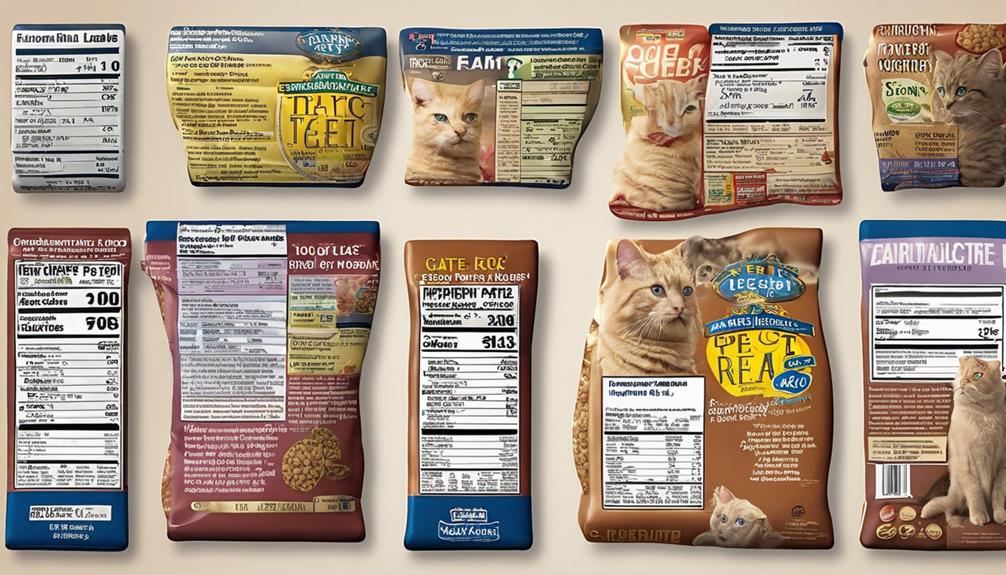
Guaranteed analysis plays an essential role in understanding the nutritional breakdown of cat food. It allows us to compare the protein, fat, fiber, and moisture content of different products accurately.
Nutrient Breakdown Importance
Analyzing the nutrient breakdown of cat food is essential for evaluating the protein, fat, fiber, and moisture levels important for a cat's health. Guaranteed analysis provides critical insights into the nutrient content based on dry matter, helping us make informed decisions about our feline friends' nutrition.
Protein plays an essential role in a cat's diet, ensuring they receive the necessary amino acids for muscle maintenance and overall well-being. Fat content provides energy and aids in the absorption of essential vitamins for their health. Additionally, fiber content influences digestion and bowel movements, impacting their overall health.
Understanding these key components allows us to select cat food that meets their specific dietary needs, promoting a happy and healthy life for our beloved companions.
Comparing Nutritional Values
To properly assess the nutritional value of cat food, one must compare the protein, fat, fiber, and moisture levels provided by the guaranteed analysis on a dry matter basis. Understanding this information is essential for evaluating the quality of cat food accurately. Here is a comparison table to help you navigate the nutritional values of different cat food products:
| Nutrient | Protein (%) | Fat (%) | Fiber (%) |
|---|---|---|---|
| Brand A | 35 | 15 | 5 |
| Brand B | 30 | 12 | 4 |
| Brand C | 40 | 18 | 3 |
Analyzing the guaranteed analysis allows us to make informed decisions about our feline friends' diets. Remember, protein is especially important for obligate carnivores like cats.
Diving Into Nutritional Analysis
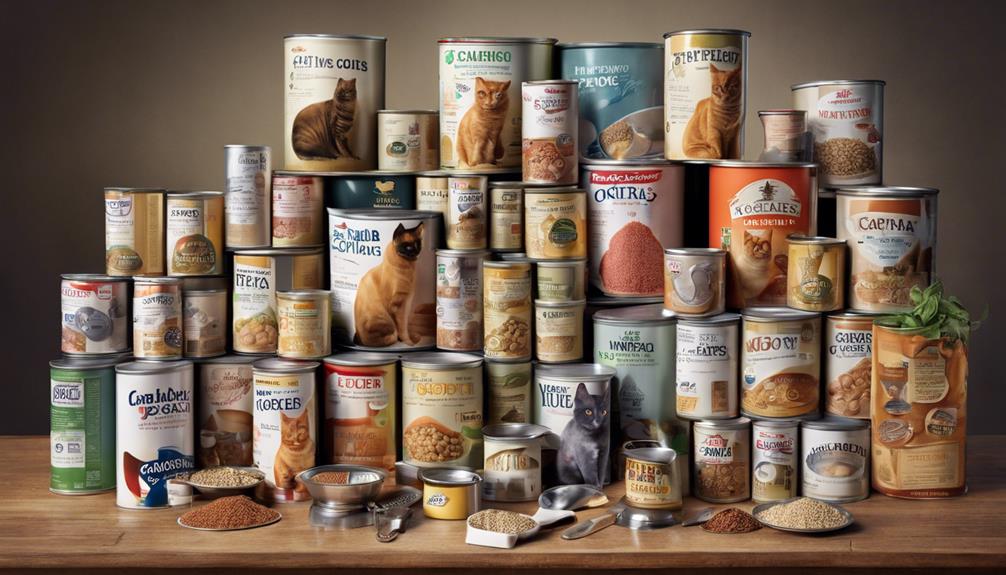
When examining cat food labels, focus on the protein and carbohydrate content to make well-informed choices for your feline friend's nutrition. In wet cat food, protein content typically hovers around 80% on a dry matter basis, with carbohydrates close to 0%. This high protein content mainly stems from meat sources, guaranteeing your cat receives the essential nutrients it needs.
Analyzing nutritional content on a dry matter basis allows for precise comparisons between different cat food options. To prioritize your cat's health, steer clear of ingredients like corn, rice, soybean, and wheat, as they may not provide the quality nutrition your cat deserves.
Prioritizing Fresh Meat

Fresh meat plays a crucial role in a cat's diet, offering essential nutrients and meeting their biological requirements for peak health and vitality. When selecting cat food, prioritize options that contain real meat as the main component. Here are some key points to keep in mind:
- Choose cat foods with specific meat sources like chicken, beef, or lamb listed first on the ingredient list.
- Make sure that the cat food provides high levels of animal-based protein to support your feline companion's health and energy needs.
- Avoid products that include fillers such as grains, soy, and by-products, as they may not offer the necessary nutritional value for your cat's well-being.
Balanced Homemade Options
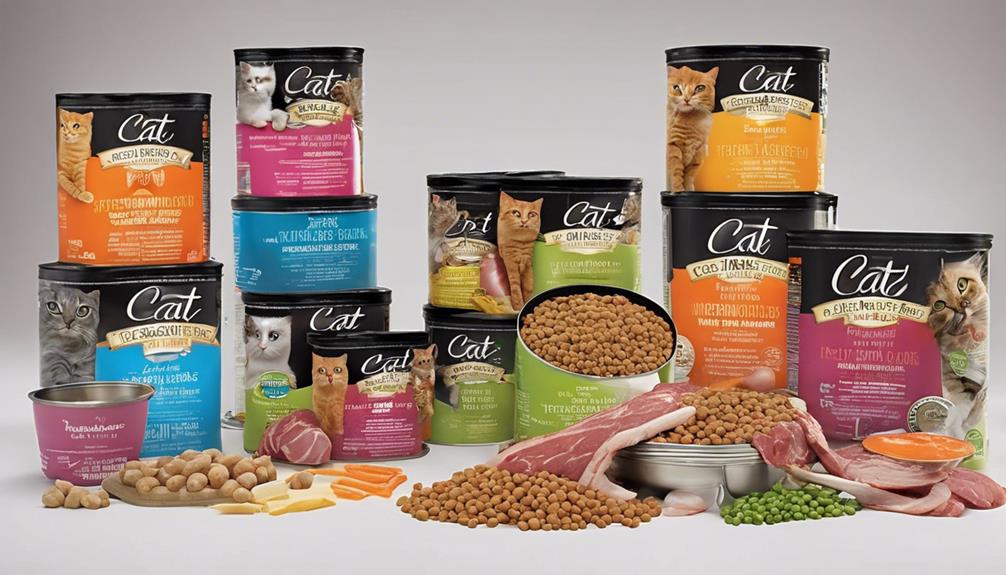
When it comes to homemade cat food, ensuring a balanced diet is essential for our feline friends. Nutritious homemade meals can be tailored to meet our cats' individual nutritional needs by incorporating a variety of meats, organs, and bones.
Nutritious Homemade Cat Meals
For ideal feline nutrition, homemade cat meals should incorporate a balance of fresh meat, organs, and bones to meet their dietary requirements.
- Variety of meats, such as chicken, turkey, and beef, provide essential nutrients.
- Homemade food allows control over quality ingredients, eliminating harmful additives.
- Supplementing with essential vitamins and minerals guarantees a complete diet for feline health.
Ingredient Sourcing for Cats
We prioritize sourcing high-quality ingredients to create well-balanced homemade cat meals that meet the dietary needs of our feline companions. Fresh meat, raw bones, and organs are essential for cats as obligate carnivores. Our homemade cat food includes high-quality protein sources like muscle meat, heart, liver, and kidney.
Variety in ingredient sourcing guarantees a wide range of essential nutrients for our cats. It's vital that the meat and organs we use are fresh, high-quality, and free from additives or preservatives. We carefully balance the ratio of meat, bones, and organs to mimic a cat's natural diet in the wild.
Proper Portions for Felines
To guarantee our homemade cat meals are well-balanced and meet our feline companions' dietary needs, it's essential to comprehend the proper portions for felines, focusing on balanced homemade options.
When preparing homemade cat food, remember these key points:
- Aim for a diet of 80% lean muscle meat, 10% raw edible bone, 5% liver, and 5% other secreting organs.
- Provide a variety of protein sources like chicken, turkey, rabbit, and fish for a well-rounded diet.
- Include essential supplements such as taurine, omega-3 fatty acids, and a balanced vitamin and mineral mix to make sure your cat's nutritional requirements are met.
Transitioning to Raw Food

When converting your cat to a raw food diet, it's crucial to follow a gradual process to avoid digestive issues. Cats shouldn't be fed raw and kibble diets simultaneously, as this can lead to tummy troubles.
To shift smoothly, it's recommended to move from kibble to wet food first before introducing raw meals. Raw cat food options typically include USDA-inspected meats, organs, raw meaty bones, and essential nutritional supplements to guarantee a balanced diet.
Companies like Raw Paws Pet Food offer a variety of raw cat food choices, such as frozen meals, whole meat chunks, organ meats, and freeze-dried treats.
Gradual Shift to Raw Diet

When shifting your cat to a raw diet, it's important to take it slow to prevent any tummy upsets.
Start by introducing wet food gradually before making the change to raw options.
This method helps your feline friend adjust smoothly to their new diet and guarantees they receive the essential nutrients for their well-being.
Benefits of Raw Diet
Shifting your cat to a raw diet gradually is crucial for their digestive health and overall well-being. Cats benefit from the high-quality protein and essential nutrients in fresh meat, bones, and organs. Introducing slowly prevents digestive issues and helps your cat's system adjust smoothly.
It's important to avoid mixing raw food with kibble to prevent potential digestion problems and guarantee your cat reaps the full benefits of a raw diet. Opt for USDA-inspected meats, organs, raw meaty bones, and necessary nutritional supplements for a balanced diet.
Companies like Raw Paws Pet Food offer convenient options such as frozen raw meals, whole meat and organ chunks, and freeze-dried meat treats to support a gradual shift to a raw diet.
Transitioning Tips
To smoothly shift your cat to a raw diet, it's important to gradually introduce fresh meat, bones, and organs, ensuring their system adjusts well to the new food. Cats are sensitive to dietary changes, so shifting from kibble to wet food, and then from wet to raw food, is vital.
Mixing raw and kibble diets should be avoided to prevent digestive issues. When making the change, opt for USDA-inspected meats, organs, raw meaty bones, and nutritional supplements for a balanced diet. Consider convenient options like frozen raw meals, whole meat and organ chunks, and freeze-dried meat treats from Raw Paws Pet Food.
Slowly introducing raw food helps cats adjust while providing essential nutrients for their health and well-being.
Meal Preparation Tips
For a smooth switch to a raw diet for your cat, start by gradually incorporating fresh meat, bones, and organs into their meals while ensuring their system adjusts well to the new food.
- Introduce a variety of raw cat food options, including USDA-inspected meats, organs, raw meaty bones, and nutritional supplements.
- Avoid mixing raw and kibble diets due to different digestion rates and requirements for cats.
- Consider using frozen raw meals, whole meat and organ chunks, and freeze-dried meat treats from trusted brands like Raw Paws Pet Food.
Transitioning your cat to a raw diet requires patience and attention to their individual needs and preferences. By following these meal preparation tips, you can help your feline friend thrive on their new diet.
High-Quality Raw Food Options
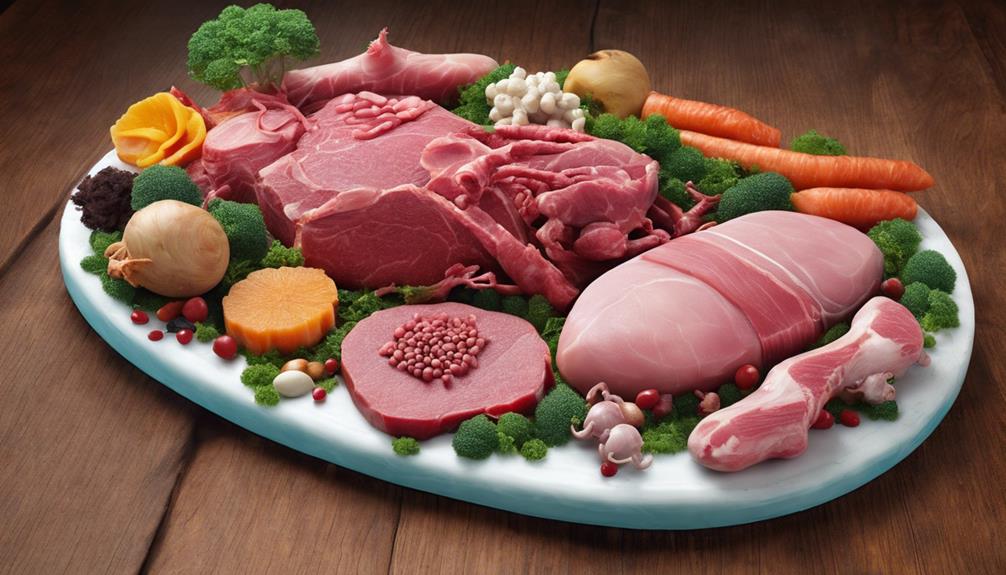
When contemplating top-notch raw food choices for your cat, prioritizing complete and balanced diets like those offered by Raw Paws Pet Food is crucial.
Raw Paws Pet Food provides a variety of frozen raw meals specially crafted for cats, guaranteeing they receive the nutrients they require. These meals contain USDA-inspected meats, organs, and raw meaty bones to replicate a natural feline diet, promoting excellent health and well-being for your furry companion.
Additionally, Raw Paws Pet Food offers whole meat and organ chunks, ideal for pet owners who prefer creating balanced homemade raw meals for their cats.
For those seeking to add diversity to their cat's diet, the freeze-dried meat treats from Raw Paws Pet Food are a convenient and nutritious choice.
Introducing your cat to raw food from reputable brands like Raw Paws Pet Food can provide the ideal nutrition for obligate carnivores like cats. Trusting in high-quality raw food options ensures your cat's dietary needs are met with wholesome and natural ingredients.
Ingredients to Avoid

When selecting cat food, we must be cautious about certain ingredients that are best avoided. When picking the right food for our feline friends, it's crucial to steer clear of:
- Corn, rice, soybean, brewers yeast/rice, and wheat: These are inexpensive fillers that may not provide the necessary nutrients for your cat.
- Sugar, cellulose, artificial colors, meat by-products, animal digest, poultry fat/by-products/meal, and fish oil: These ingredients can be harmful to your cat's health and well-being.
- Certain preservatives: Opt for cat foods that avoid preservatives that could potentially have a negative impact on your cat's overall health.
Quality of Cat Food

Inspecting the meat content in the product name provides a clear indicator of the quality of cat food. When scanning the ingredients list, look for protein as the primary component in top-quality cat food. Ingredients listed by predominance offer valuable insights into the nutritional value of the product.
It's important to steer clear of cat foods that contain cheap fillers like corn, rice, soybean, brewers yeast/rice, and wheat, as these can detract from the overall quality. To truly understand the quality of cat food, familiarize yourself with product name rules, ingredients, and guaranteed analysis based on a dry matter basis.
Comparing Product Names

To accurately compare cat food product names, focus on understanding the meat content requirements associated with specific terms. When evaluating different cat food labels, keep in mind the following key points:
- Product names featuring 'chicken,' 'beef,' or 'turkey' should contain a minimum of 95% of that meat on a dry matter basis.
- Names including 'dinner,' 'platter,' or 'entree' must have at least 25% of the named ingredient.
- Labels with 'with' in the name are only required to include 3% of the specified meat.
Understanding these guidelines is essential for making informed decisions about the meat content of cat food products. By paying attention to these details, you can make sure that you're selecting high-quality options that meet your feline friend's dietary needs. Remember, the product name provides valuable clues about what's inside the packaging, helping you choose the best food for your beloved pet.
Consideration of Labeling Rules
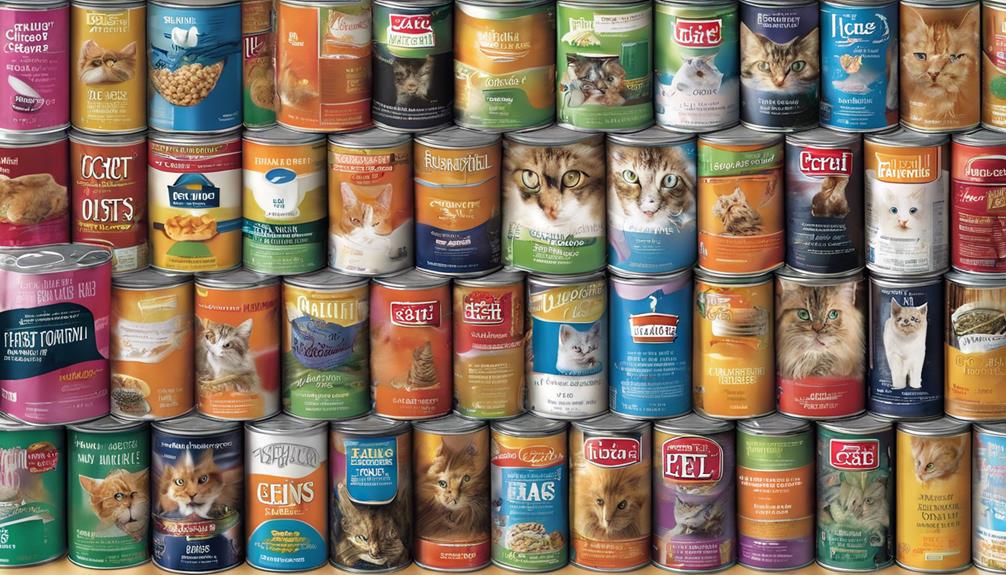
Regularly considering labeling rules is essential for accurately evaluating the meat content and quality of cat food products. By understanding the rules governing product names, we can decipher vital information about what our feline companions are consuming.
Descriptive names often indicate a blend of ingredients, while simpler names tend to signal a higher meat content. Keep an eye out for the word 'with' in product names; its presence typically suggests a lower meat content in the cat food. These nuances in labeling can make a significant difference in the nutritional value your cat receives.
Being aware of these labeling rules empowers us to make informed decisions about the best food options for our beloved pets. The next time you're browsing the cat food aisle, take a moment to scrutinize the product names. It might just lead you to choose a better quality option that meets your cat's dietary needs.
Frequently Asked Questions
What Are the Requirements for Cat Food Labeling?
We must grasp the requirements for cat food labeling. It's vital to know that pet food labels must adhere to AAFCO guidelines to guarantee accuracy. State feed laws often reference AAFCO's regulations, assisting pet owners in making informed decisions.
What Is the 25% Rule in Pet Food?
Understanding the 25% rule in pet food requires the named ingredient to be at least a quarter of the product weight. This helps consumers comprehend what's in the food they purchase for their pets.
How Do I Read Cat Food Labels?
When we read cat food labels, we focus on the guaranteed analysis to assess nutritional value accurately. We consider the protein sources listed in the ingredients to gauge quality. Evaluating the product name helps determine meat content for better choices.
How Do I Know What Cat Food to Feed My Cat?
We choose cat food based on meat content, prioritizing products listing meat first. Simple names usually mean more meat. Evaluating the guaranteed analysis helps us select quality food. Understanding product name rules is essential.
Conclusion
In summary, grasping the vital aspects of cat food names is essential for providing your feline friend with the best nutrition. By deciphering product names, evaluating meat content, and avoiding harmful ingredients, you can guarantee that your cat's diet is of high quality.
Remember to always read labels carefully and compare different options to make informed decisions. Your cat's health and well-being depend on it.










